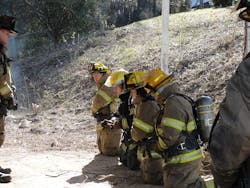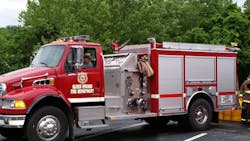The Yearly Training Calendar: A Framework for Success
“Congratulations, you are the new training officer!” These words can strike excitement and anxiousness at the same time. This usually is followed by, “What’s your idea for the training program for next year?”
This scenario plays out every year for many volunteer fire departments. For the new training officer, this can seem like a daunting task. However, with the proper framework, everyone can be successful in developing a yearly training calendar.
Needs assessment
When training officers are tasked with developing their department’s training program, they first might ask themselves, “Where do I even start?” The answer is a training needs assessment.
Without a thorough assessment of your department’s needs, you might find yourself instituting training that offers very little return on investment. A volunteer’s time is a hot commodity, and any time that’s spent training shouldn’t be wasted on items that don’t yield a high return. The needs assessment must focus on the risk factors that are present in the community, fireground and historical data, and federal and state regulatory compliance.
When the training officer looks at the community’s risk factors, a few things must be considered. Look at census data to determine whether the community has grown. With growth comes new development and increased call volume. For example, consider a community that’s seeing farms being sold and developed into subdivisions. Where the community once might have had hundreds of feet between structures, it now has areas where structures are separated by 50 feet. This requires the department to train on exposure protection and water supply techniques that it previously never might have had to focus on.
As well, determine whether the department experiences seasonal fire situations that might increase your need to train members in wildland firefighting tactics.
In regard to department historical data and fireground experiences, comb through your records-management system and analyze 2–5 years of call data, including the types of calls. This can allow you to focus your training program on areas of need, such as water rescue awareness because of an increase in floodwater rescues.
When looking at fireground experiences, ask your membership, “What areas do we need to focus on?” Also, use photographs and videos from on-scene operations to identify deficiencies.
The last assessment is for compliance. Are all of your members in compliance with state or federal regulations? Do they meet minimum training requirements for their position? This assessment can be done by looking at training records versus compliance standards, such as Occupational Safety and Health Administration (OSHA) or NFPA. Some states might have additional training compliance standards.
Training calendar breakdown
The training calendar is the go-to source for the entire department for information in regard to the training program for the year. It must be easy to read, and every member must have the ability to decipher different training needs, both individually and for the department’s goals.
The training calendar should be, in fact, three different calendars in one. The three calendar sections should be yearly compliance, weekly/monthly in-service and professional development.
Yearly compliance training for OSHA and other regulatory compliance must be completed by every member of the department. This calendar typically is the easiest of these to construct, because it can be completed at the same time every year.
Compliance training schedules must meet the needs of the individual department. In other words, some departments complete all of the required compliance training in a single month; some complete all of the training over a year. This isn’t a one-size-fits-all proposition.
Examples of yearly compliance training can include:
- OSHA Bloodborne Pathogen
- OSHA Respiratory Protection
- Annual driver compliance training
- HIPAA compliance training
Possible resources to seek out include your state’s OSHA office, your state fire marshal’s office and local safety officials. Each state is different in some degree.
Weekly and monthly in-service training takes up the brunt of the yearly schedule and is the area where most training officers struggle. That said, this is the area that the training officers can mold to their department. You should focus on items that are noted in your needs assessment.
An item that often worries training officers is how many hours to include. I utilize ISO as a guideline: ISO guidelines state that each member should receive 18 hours of in-service training per month and an additional 16 hours of facilities training per year. This equates to 232 hours per year of training. Admittedly, that’s a lofty goal for members of a volunteer agency, given all of their other commitments. I recommend finding a number of hours that fits your department. I often suggest at least three hours of training once per week. This amounts to at least 156 hours per year for every member of the department.
Usually after the “How many hours of training?” question comes “What topics should we put into our department training program?” Don’t overthink the answer. Look back on your needs assessment. For example, if you identified that your community has several houses that have limited access and long driveways, a topic might be to practice long hose deployment.
Sometimes the most simplified plan is the most effective plan. Fight the urge to add in every topic to your in-service training. For instance, if you don’t have any standpipe systems in your immediate or mutual aid response district, standpipe evolutions can be construed as wasted time by your membership. Remember, every training must be applicable to the job that the member is expected to perform or to a problem that a member might face.
Seasonal pattern is another area to consider when planning topics. The main focus here could be weather pattern shifts or even seasonal call volume. For example, if your area experiences freezing temperatures in January, it might not be productive to schedule pump training that involves tanker shuttles and drafting during that time. Taking seasonal patterns into consideration also can allow you to focus training on certain seasonal hazards, such as ice rescues or wildland firefighting.
Professional development
Professional development training often is overlooked in the volunteer fire service. This section of the calendar can be broken into ongoing training and initial training. Both are equally important.
Ongoing professional development training is for members who already achieved a specialized position, such as driver/operator or officer. The requirements for ongoing development training can come from national standards or guidelines. One example is that both officers and driver/operators require 12 hours of annual training because of the special nature of the position that they hold.
A sample guideline for ongoing professional development training would be quarterly sessions. This approach allows for continuous training while not overwhelming the member who also has other additional training requirements.
Initial professional development training is scheduled throughout the year to meet the needs of each member as well as certification goals of the department in accordance with NFPA guidelines. An example would be a driver/operator class to certify members to the NFPA 1002: Standard for Fire Apparatus Driver/Operator Professional Qualifications.
Not every initial professional development class must be scheduled every year. This schedule should be based on your analysis of individual training records. Also, creating professional development goals for each of the department’s firefighters assists in the planning of these classes.
Tips and resources
Developing a training calendar can seem challenging. The good thing is that, with the internet and networking opportunities, such as Firehouse Expo, you easily can gain resources and tips to assist you with the task. One example of this is learning about the importance of backup plans. Always have them. It never fails: You have a training topic of stretching and flowing hoselines, and a continuous thunderstorm happens, or you have a lower turnout of members for training than what’s required. Move to a backup training drill or, maybe, switch training topic days.
The COVID-19 pandemic has made computer-based training a need within every fire service organization. Using platforms, such as Vector Solutions, can assist you with your training calendar development and delivery. Between their prebuilt classes and training calendars, such platforms can give members options for obtaining training when they have the inability to make it in person to the department’s scheduled training night.
Utilizing these types of systems to complete annual compliance training allows regular training to be focused on other topics, such as establishing water supplies or initial hoseline operations (versus annual bloodborne pathogens training, for instance). Department members often find this tactic appealing, because establishing water supplies or initial hoseline operations and other regular training quite often are viewed as more job focused.
Resources for topics and class guidelines can come from many sources. UL and National Institute of Standards and Technology have many resources that cover recent fire test studies. Utilizing National Institute for Occupational Safety and Health firefighter fatality reports as case studies allows members to learn from past incidents that resulted in the death of a firefighter. Firehouse Magazine and Firehouse.com provide articles and lesson plans.
Although developing a yearly training program can seem like a challenge, proper planning and research can assist you. Also, seek out the assistance of others who are in the same position as you.
About the Author

Justin Bailey
Justin Bailey is the fire chief of the Oliver Springs, TN, Fire Department and a 20-year student of the fire service. He also holds the rank of master firefighter with the Knoxville, TN, Fire Department, where he has served since 2007. Bailey has an associate degree in allied health science from Roane State Community College and a bachelor's degree in fire administration from Columbia Southern University. He speaks regionally and nationally on the topics of volunteer training program development, professional development and rural fireground management.

